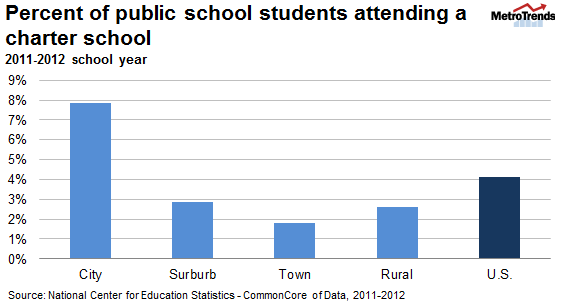
Charter schools are one of a number of school reform strategies that aim to expand choices for families. Other school choice policies include open enrollment, magnet or alternative schools, private school vouchers, tax credits for households paying for private school, and homeschooling. Although the number of cities with open enrollment and magnet schools is growing, charter schools represent the most prevalent type of school choice strategy in the United States today.
Charter schools are independently governed and run public schools that are supported with public funds. In the 2011-12 school year, there were about 5,700 charter schools in 42 states serving over 2 million children. That represents a 186 percent increase in the number of charter schools and a 359 percent increase in the number of students attending charter schools since the 2000-01 school year.
Charter school students still represent a small proportion of all students in the US (4.2 percent), but the speed at which their numbers are growing and where these students are located raise important questions for students, families, neighborhoods, and cities.
Where are charter schools located?
Charter schools are more prevalent in cities than they are in suburban or rural areas; 55 percent are located in central cities (compared with 24 percent of traditional schools), 29 percent are located in suburbs and towns (compared with 42 percent of traditional schools), and 16 percent are located in rural areas (compared with 34 percent of traditional schools). Their reach is increasing, too—they represented 12 percent of all public schools in cities in 2011-12, up from 7.5 percent in 2005-06.
This pattern is also reflected in enrollment patterns. A greater proportion of students attend charter schools in cities (8 percent) than in the suburbs, towns, and rural areas. The map below illustrates where the concentration of students attending charter schools is greatest, highlighting distinct state patterns that largely reflect differences in charter legislation.
What does charter school growth mean for cities?
Right now, there is little empirical evidence about how charter schools will affect neighborhoods and cities. We don’t know how growing demand for charter schools affects neighborhood residents or institutions. We don’t know how families communicate or build trust with their neighbors in places where children attend many different schools. And we don’t know whether charter school choices in cities will change where families with children choose to live and stay.
What we do know is that although the proportion of public school students attending charter schools is currently still relatively small, their growth in cities will likely have important implications for cities and their neighborhoods.
Photo by Elaine Thompson/AP
Tune in and subscribe today.
The Urban Institute podcast, Evidence in Action, inspires changemakers to lead with evidence and act with equity. Cohosted by Urban President Sarah Rosen Wartell and Executive Vice President Kimberlyn Leary, every episode features in-depth discussions with experts and leaders on topics ranging from how to advance equity, to designing innovative solutions that achieve community impact, to what it means to practice evidence-based leadership.
